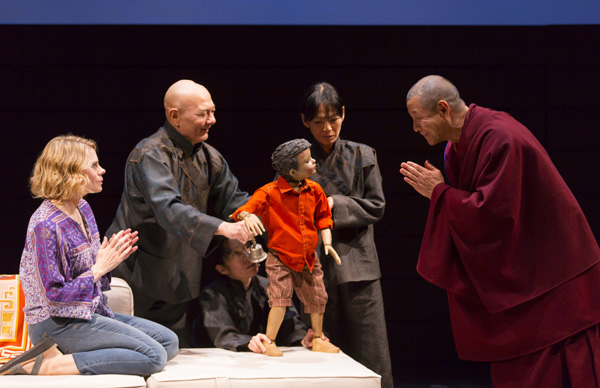The Oldest Boy

(© T. Charles Erickson)
"China invaded Tibet in 1949, under the leadership of Mao," Sarah Ruhl writes in the program note for her newest play, The Oldest Boy, now making its world premiere at Lincoln Center Theater's Mitzi E. Newhouse Theater. "More than a million Tibetans were killed. 6,256 monasteries were destroyed and looted, fourteen remain intact.'' The shocking facts of Chinese brutality in Tibet are undeniable. Curiously, however, Ruhl never mentions what Tibet was like before Chinese occupation, when the vast majority of Tibetans lived as serfs supporting a handful of noble families and a massive Buddhist clergy. The Western propensity to overlook (or even romanticize) Tibet's feudal theocracy is very much at the heart of Ruhl's earnest and slightly naive play. Why do we castigate certain oppressive systems while valorizing others? More important: Whose version of the truth is deserving of our faith and trust?
The play takes place in an American city with a large Tibetan community (Ruhl never specifies which). Tenzin is a seemingly average American boy, raised by an American mother (Celia Keenan-Bolger) and a Tibetan father (James Yaegashi) living in exile. (Ruhl also never gives these characters specific names.) Tenzin's mother and father met when she stumbled into his restaurant one day and never wanted to leave, so enchanted was she with the food and the man who cooked it. Against his family's wishes, they marry and have a son. Three years later, a Tibetan lama (James Saito) and a monk (Jon Norman Schneider) arrive at their home. They suspect that Tenzin is the reincarnation of a great lama (Buddhist teacher) and want to take him to India to begin his spiritual training. Naturally, the mother is hesitant. Since meeting her husband, she's had a deep interest in Buddhism, but it has never challenged her to make a real sacrifice. She has to decide if she really believes, or if this is no different from the faith of her childhood: a tribal identity based on fear of the unknown.
"…There were those — sort of — problems? — in the church — you know," the mother haltingly alludes to the widespread history of sexual abuse in the Catholic Church when the monks ask about her estrangement from that religion. This mother would never entertain the idea of sending her three-year-old son off to live in the mountains with a bunch of Catholic priests. So why do these robe-wearing and allegedly celibate men of God get the benefit of the doubt? In this moment, the issue of trust (who gets it? who does not? and why?) comes into sharp focus.
Ruhl barely scratches the surface of these questions, and by the end we're left with few new insights. The monk and lama are smiling Buddhist cardboard cutouts, never revealing any sense of human weakness or vulnerability. Even in light of their apparent perfection, The mother's driving motivation seems to be guilt over the sacrifices her husband has made to accommodate her and her American way of life. "I gave up my family for you," he shouts at her. So why can't she give up her son? As an ex-Catholic, guilt is an emotion she knows well.
Keenan-Bolger takes this between-a-rock-and-a-hard-place situation and milks it for all it's worth. She's a nervous ball of worry, but also a clearly intelligent woman. Remarkably, her ambivalence becomes understandable. As the Father (the play's only other fully formed character), Yaegashi is also able to elicit our sympathy as a man torn between two families, facing the prospect of saying goodbye to his firstborn.
Unfortunately, this sympathy is rather undercut by the manner in which the child is presented onstage: Tenzin is portrayed by a Bunraku-style puppet with three operators, one of whom (Ernest Abuba) speaks (or in this case, whines) the boy's lines. He never seems like a real boy but an obnoxious imitation that occasionally glides from one piece of furniture to the next like a flying squirrel. Even though we feel bad for his mother, it's difficult to be saddened by the prospect of his disappearance from the stage.
There are many bright spots in director Rebecca Taichman's production: Mimi Lien's versatile set captures the austerity of Tibetan Buddhism and contemporary American interior design in equal parts. Anita Yavich's beautiful costumes dance across the stage in authentic-looking choreography by Barney O'Hanlon. In a stunning collaboration between Lien and lighting designer Japhy Weideman, a rectangular playing space bathed in an incandescent glow dominates the upstage wall, expanding and contracting as necessary. It helps clarify time and place (and is absolutely gorgeous).
As visually arresting as the production is, it still doesn't compensate for a story that seems to rest on a rather tired cliché: the American of a certain class and educational background enchanted with Buddhism and the Free Tibet movement. The premise is also not very different from the 1993 Keanu Reeves movie Little Buddha. At least with Keanu we learned a little about Buddhism. The Oldest Boy is more notable for what we do not learn.










